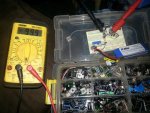- Joined
- Dec 17, 2016
- Messages
- 7
- Points
- 0
I built my own driver so I can play around with a bunch of diodes I hacked out of lightscribe drives. I have a flat package 790? (Near ir at least) with a standard glass aixiz lens and an open can red with a g2, both smoking an old shoe over 10 feet away. Pretty awesome for a n00b imo, but when I had everything hooked to my test circuit I couldn't get my driver much higher than (an estimated) 250mA. My dmm stops at 200mA before I have to switch the cable and range but I got skittish after I led'd a good can trying to switch it while it was running. :durr: Anyhow, my setup is as follows:
lm317t
5ohm 1/2 or 3/4 watt resistor
1k 15 turn pot (all I could find at radio shack)
4001 diode
16v 47 uf cap.
Power source is an eflite 7.4v 800 mAh lipo
From what I've read this setup SHOULD be outputting up to 500mA. I do plan on picking up a 100 ohm pot (or twelve) and im waiting on a couple chinese noname drivers but I plan on running a similar circuit to this on the engraver I'm building so I'd like to figure out what I'm doing wrong.
lm317t
5ohm 1/2 or 3/4 watt resistor
1k 15 turn pot (all I could find at radio shack)
4001 diode
16v 47 uf cap.
Power source is an eflite 7.4v 800 mAh lipo
From what I've read this setup SHOULD be outputting up to 500mA. I do plan on picking up a 100 ohm pot (or twelve) and im waiting on a couple chinese noname drivers but I plan on running a similar circuit to this on the engraver I'm building so I'd like to figure out what I'm doing wrong.
Attachments
Last edited:







